20 Tips and Tricks on How to Speed Up Windows 10 2019/2020/2021
How to speed up Windows 10 and make it run faster? This article provides you with the most comprehensive solutions, and there must be ones that work for you.
| Workable Solutions | Step-by-step Troubleshooting |
|---|---|
| Fix 1. Restart Your PC | Restarting PC clears out the computer's memory and stops processes that are taking up resources...Full steps |
| Fix 2. Install the Latest Update | Ensure that you have the latest version of Windows 10. When you check for updates, your computer...Full steps |
| Fix 3. Change the Power Settings | The power plan you are using can save energy by decreasing your computer's performance...Full steps |
| Fix 4. Check Startup Apps | Windows 10 PC can become bogged down by the sheer number of running processes. Check startup...Full steps |
| Fix 5. Defrag Your Hard Disk | You can rearrange the files on a disk to occupy contiguous storage space, which will speed up file...Full steps |
| Fix 6. More Effective Tips | Use ReadyBoost, clean up disks, increase system C drive, clean out your Registry, disable OneDrive...Full steps |
Although Windows 10 is getting faster, more stable and powerful, your PC or laptop may slow down due to various factors, including but not limited to compatibility issues, bugs, viruses, bloated software, hardware failures, or other issues. This article is for users with the following questions.
- How to speed up Windows 10 startup?
- How to speed up Windows 10 for gaming?
- How to make Windows 10 faster on laptop and PC?
- How to speed up Windows 10 with command prompt?
On this page, we will walk you through 20 effective methods to speed up Windows 10, optimize and improve your computer performance.
1. Restart Your PC to Speed Up Windows 10
Restarting your PC should be the first step in speeding up Windows 10. It can clear out the computer's memory and stop any processes that might be taking up resources. When you run your computer for a long time without shutdown, Windows 10 will automatically put the display to sleep, but the processes that were started before will continue to run. These will accumulate over time and slow down your computer.
You can fix this issue by restarting your PC. After your PC restarts, open just the apps you need, then close them when you're done.
2. Install the Latest Update
One of the best ways to make the most of your computer is to ensure that you have the latest version of Windows 10. Updating can fix Windows 10 very slow problem caused by system bugs. When you check for updates, your computer will also search for the latest device drivers, which can also help improve the performance of your computer and make Windows 10 faster.
Step 1. Click the "Start" button, then select "Setting" > "Update & Security" > "Windows Update" > "Check for updates".
Step 2. Select the updates you want to install, then select Install. Restart your PC and see if Windows 10 runs better.
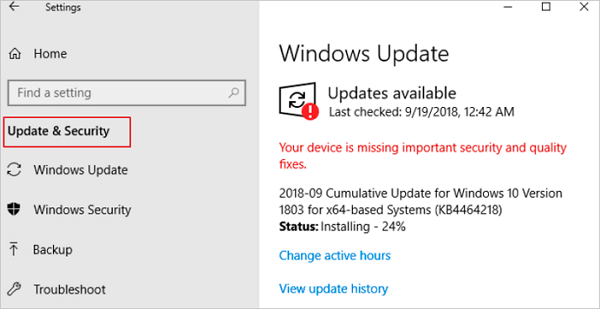
3. Change the Power Plan
It's possible that you are using a power plan that will save energy by decreasing your computer's performance. To speed up your Windows 10, you should change your plan to High Performance, which uses more energy but offers better performance of your PC. To set this power plan:
Step 1. Hit the Windows Key > type power & sleep > click "Power & sleep settings". (If you have hidden the search box, you can access the setting by going to "Start" > "Settings" > "System" > "Power & sleep".)
Step 2. Click Additional power settings on the right side.
Step 3. Expand Show additional plans, and then you will see the High-performance option. Choose it as your power plan.
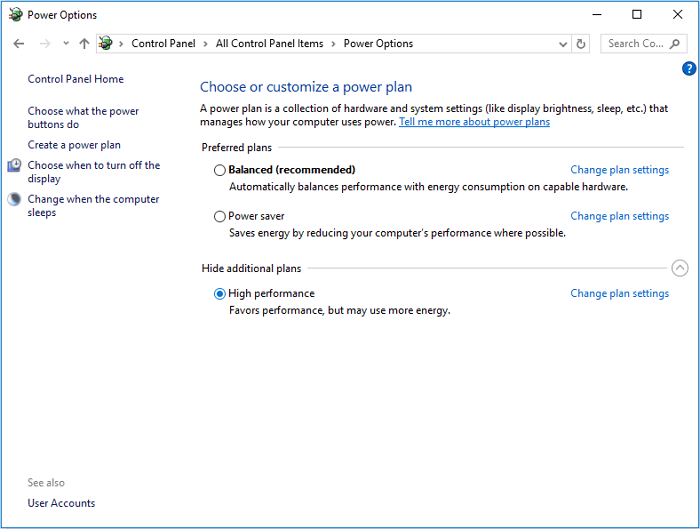
4. Disable Startup Programs
If you have too many programs starting up automatically, your boot time will increase dramatically. Also, too many apps are running in the background will make Windows 10 run sluggishly. Thus, by disabling unwanted startup programs, you can also speed up your Windows 10 tremendously.
Warning
Don't disable Microsoft programs that are necessary for booting nor the anti-virus software that protects your computer from virus attacks.
Step 1. Right-click anywhere on your taskbar and choose "Task Manager".
Step 2. In the Task Manager window, go to the "Startup" tab.
Step 3. Select the programs you rarely use, or don't always need on startup, and click "Disable" to remove it from the startup programs.
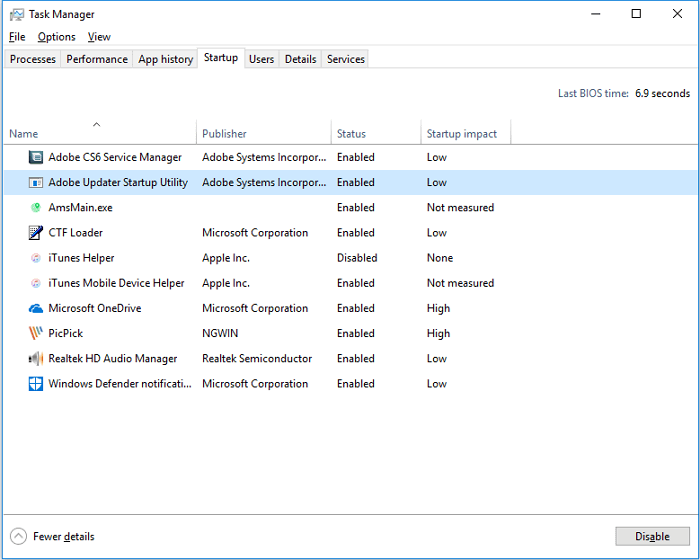
5. Defragment and Optimize Drives
With the built-in disk defragmentation utility in Windows, you can rearrange the files on a disk to occupy continuous storage space, which will speed up file access. To optimize your drives:
Step 1. Hit the Windows Key, type defragment and click "Defragment and Optimize Drives" when you see the option.
Step 2. Select your system drive (generally C drive) and click Optimize.
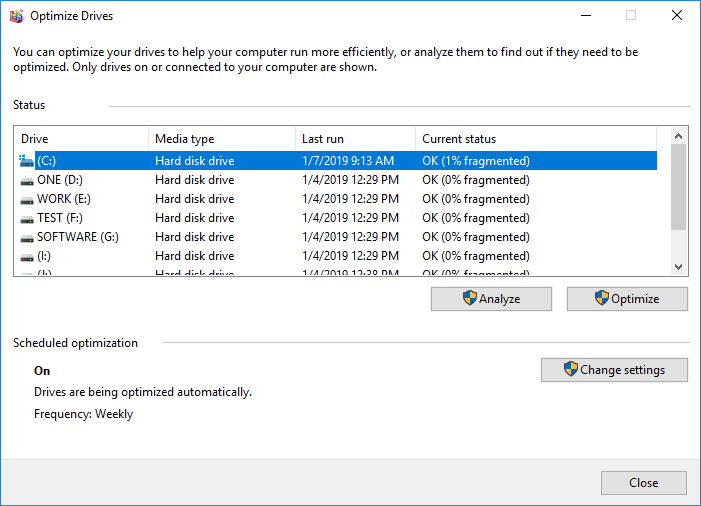
6. Use ReadyBoost to Speed Up Windows 10
ReadyBoost allows you to speed up Windows 10 and improve the performance of your computer by utilizing the available space on a removable drive, like a USB flash drive, without opening your computer and adding more memory (RAM). To use ReadyBoost, you need a USB flash drive or a memory card with at least 500MB of free space and a high data transfer rate.
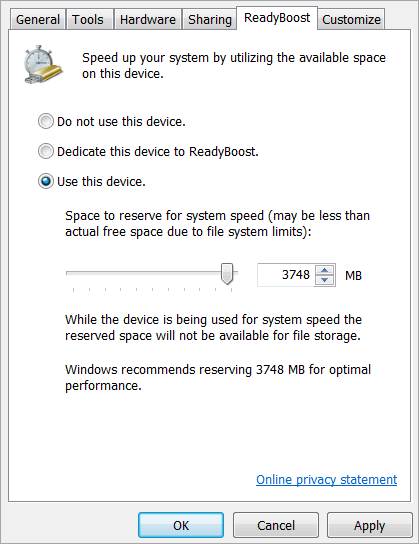
7. Clean Up Disks/Run Disk Cleanup
Unlike disk defragmentation, which rearranges the files, Disk Cleanup works to remove unnecessary files on the hard drive and help to reclaim your disk space.
Step 1. Open This PC, right-click on your system drive and choose "Properties".
Step 2. Click "Disk Cleanup" under the "General" tab, and the utility will start scanning your drive and calculating how much space you can free.
Step 3. When it is done, choose "Clean up system files" in the window to let the tool scan your disk again.
Step 4. After the second scan, click "OK" in the new window. Then you will see a notification asking you, "Are you sure you want to permanently delete these files?". Click Delete Files. Since these operations just remove unnecessary files in your system, you don't need to worry about losing important files.
If disk cleanup is not working in Windows 10, learn how to fix it first here.
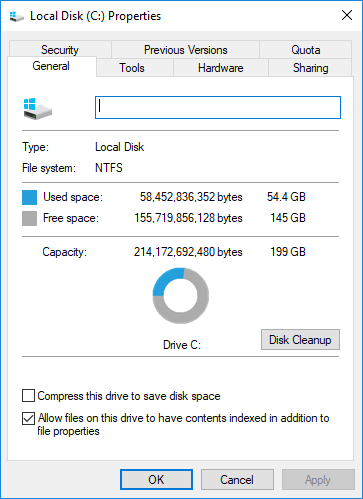
8. Delete Temp Files to Free Up Space
Temp files are files that only need to exist temporarily and will become useless later. It's unreasonable to keep these files stored on a disk that has limited space.
Does deleting temporary files speed up your computer? Definitely. Many users have reported noticeable performance improvements by deleting their temp files.
Step 1. Hit the Windows Key, type run, and click Run shown in the list.
Step 2. Type %temp% and click OK. Then you will be directed to the Windows Temp folder.
Step 3. Select and delete all the files within the folder.
Step 4. Go to the Run box again, type temp and click "OK".
Step 5. When you see a notification saying you don't currently have permission to access this folder, click "Continue".
Step 6. Select and delete all the files.
Step 7. Go to the Run box and enter prefetch. Click "Continue", then delete all files within the folder.
Notice
Although deleting the temp files is safe, if you accidentally deleted any important data on your computer while manually freeing up your disk space, you can recover windows 10 deleted files easily with the help of Deep data recovery software.
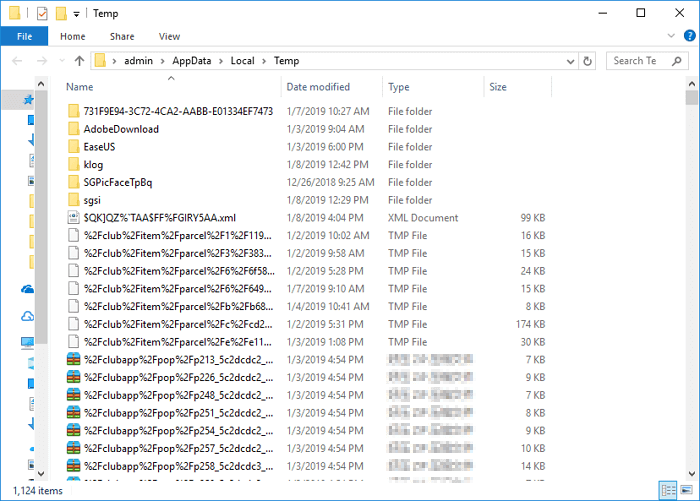
9. Extend System C Drive to Boost Windows 10 Performance
As an advanced free partition software, Qiling Partition Master Free enables you to easily enlarge your system drive to improve performance.
In addition to resizing a partition, this tool also enables you to create partitions as well as format/convert/clone/hide/wipe your disk or existing partition. In a word, it's a versatile disk/partition management tool that will help you improve your computer's performance in every possible way.
Let's see how to extend C drive with this partition management software.
Option 1. Extend System C drive with unallocated space
1. Click on the System C: drive and select "Resize/Move" in the "Disk management" page.
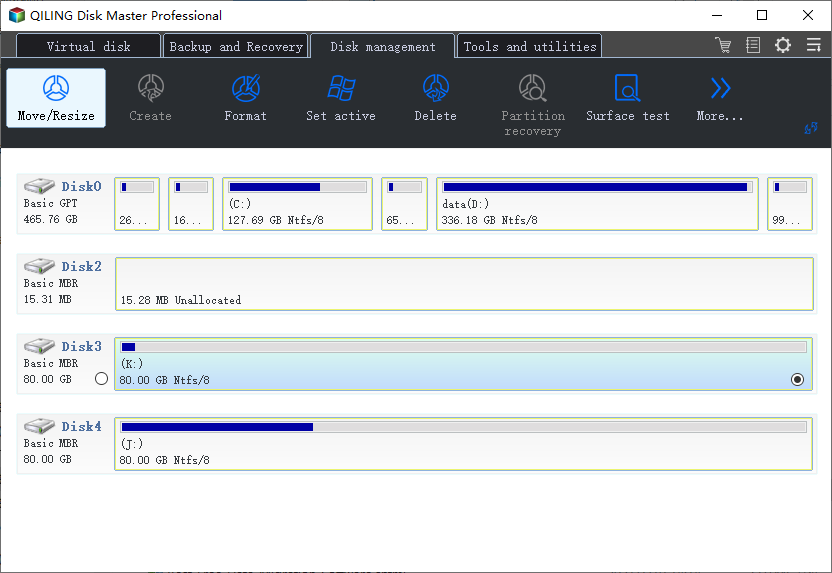
2. Drag the system partition end into the unallocated space so to add it to the C: drive. And click "Proceed".
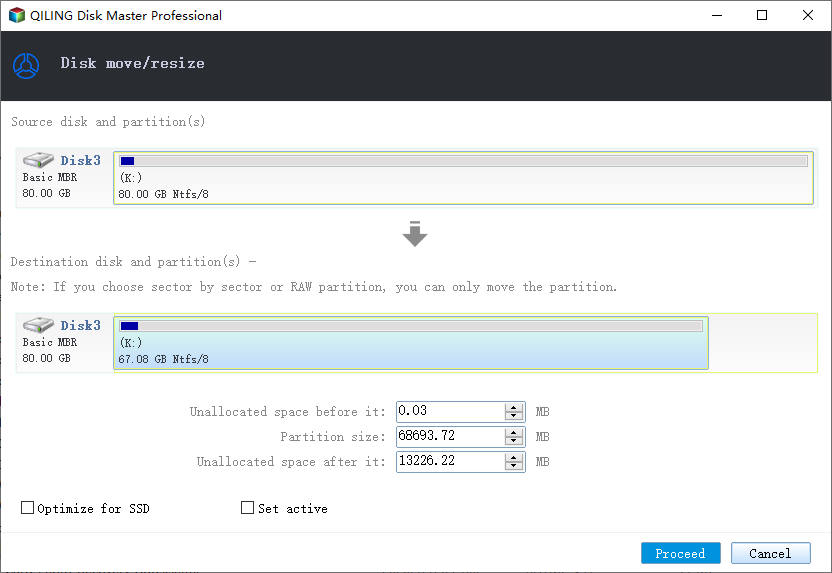
Option 2. Extend System C drive without unallocated space
1. Click on the Partition D: that next to the system C drive and select "Resize/Move" in the "Disk management" page.
2. Drag the D: partition head to right so to decrease it's size. And click "Proceed".
3. Extend System C drive with unallocated space
The pro version of Qiling Partition Master also allows you to allocate space from D drive to C drive directly to increase C drive.
10. Tweak Registry
Windows Registry holds all the settings that are needed for the Windows system and installed programs to function properly. Thus, you can tweak Registry to speed up your Windows system in many different ways. Here we'd like to present you the way to increase the mouse response time, which will help reduce the popup delay time to show popup descriptions faster when you move the mouse cursor over an item.
Warning: The Registry hosts many critical operations for your system. Removing these processes could damage your system considerably. To protect against any harmful results, follow the instructions below precisely.
Step 1. Go to the Run box and enter Regedit.
Step 2. Expand HKEY_CURRENT_USER > Control Panel and double-click on the Mouse folder.
Step 3. Double-click on "MouseHoverTime" and change the value to 10.
Step 4. Double-click on the "Desktop folder" > "MenuShowDelay" and change the value to 10.
The changes will take effect after you restart your PC. There are many other Registry tweaks that can make your Windows faster. Search on the Internet for more.
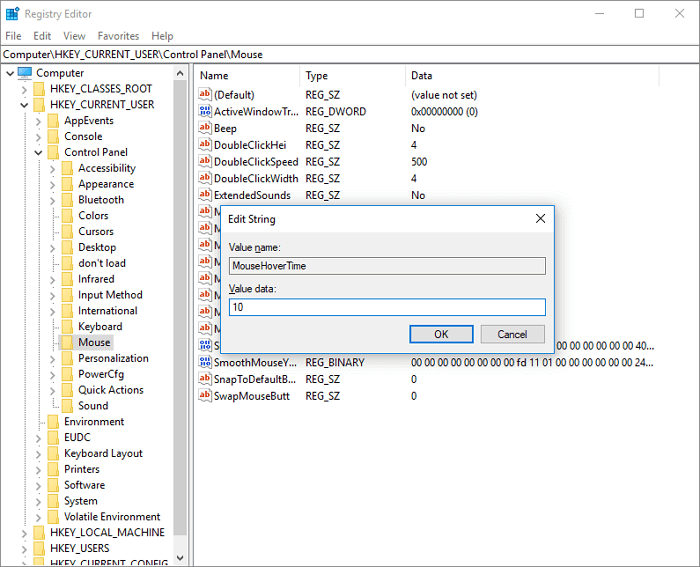
11. Disable OneDrive syncing
OneDrive is the built-in synchronization service in Windows that allows you to sync your files to the cloud and access them on any PC using the same OneDrive account. This can be a useful feature. However, the automatic syncing is likely to slow down your PC. You can easily sync an important file to OneDrive manually once automatic sync is disabled. To see whether OneDrive syncing is affecting your Windows 10 performance: Right-click on the OneDrive icon on the right side of the taskbar; Click Pause syncing and choose a time period. If you experience an improved performance of your computer during the pause, follow the steps below to turn off syncing and choose an alternative way to back up your computer that doesn't come at the cost of reducing your computer's performance.
Step 1. Right-click the OneDrive icon and select "Settings" > "Account".
Step 2. Choose "Unlink this PC" > "Unlink account".
The seven methods above are what you can do to make your Windows 10 faster while booting/running or for gaming by changing your computer settings. The next three solutions utilize third-party software to easily perform advanced tasks to speed up your Windows 10 system.
12. Adjust the Appearance and Performance of Windows
You may use many visual effects, such as animations and shadow effects on Windows 10, to make your computer look great. However, these visual effects use additional system resources and can slow down your PC. You can adjust the appearance and performance of Windows to speed up Windows 10 when your PC has a smaller amount of memory (RAM).
How to disable or adjust the visual effects in Windows 10
Step 1. In the search box on the taskbar, type Advanced system settings. Click "Advanced" tab > "Settings" > "Visual Effects".
Step 2. On the Visual Effects tab, select "Adjust for best performance" > "Apply".
Restart your PC and see if that speeds up Windows 10. If the fonts on your computer are affected, and you want to keep fonts crisp and more readable, you can select the Custom option.
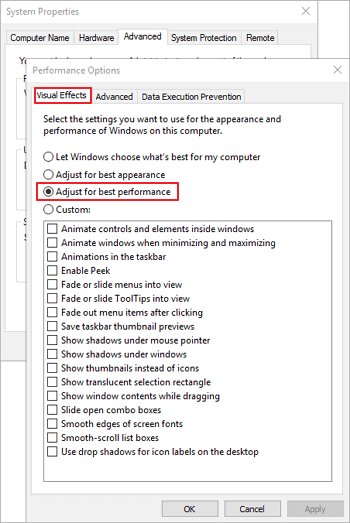
13. Disable Transparency Effect
The transparency will cost you some resources that may be one of the causes of a slow system. To reduce memory and resource consumption, you can disable transparency effects.
Open the "Settings", and go to "Personalization" > "Colors" and toggle off "Make Start, taskbar, and action center transparent".
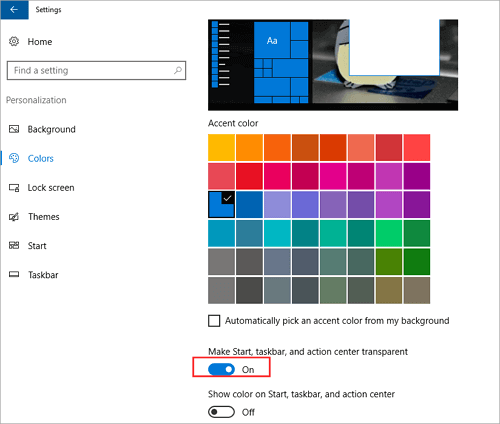
14. Migrate OS to SSD/HDD to Speed Up Windows 10
If you don't have much space on your system disk to add to your system partition, your best option is to transfer your Windows 10 to another larger HDD or to switch your system disk from HDD to better-performing SSD.
The OS migration can be completed with Qiling Partition Master mentioned above. The tutorial, including video and text, to transfer Windows to a new hard drive is thoroughly detailed in the linked article. Follow the guide to make your Windows 10 substantially faster.
Check the following steps on how to migrate OS to SSD or another bigger HDD.
Steps to migrate OS to HDD/SSD:
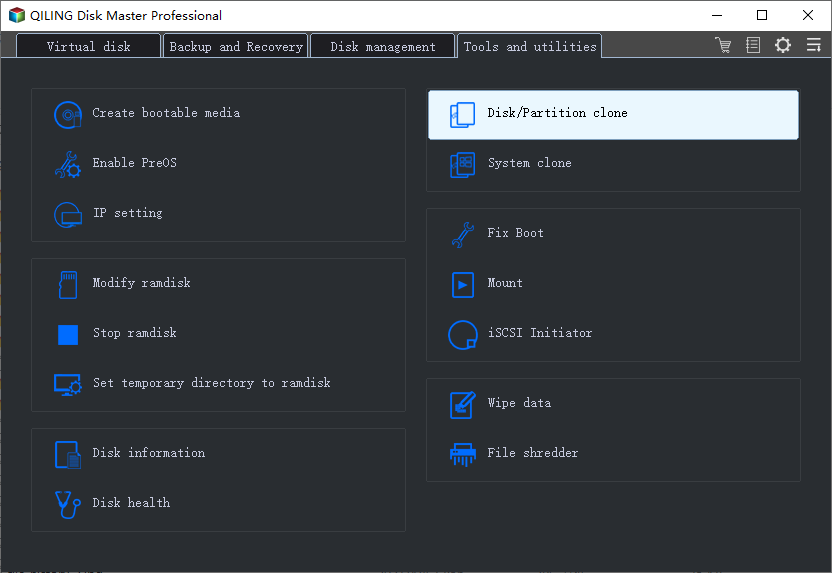
Step 2. Select the SSD or HDD as the destination disk and click Next.
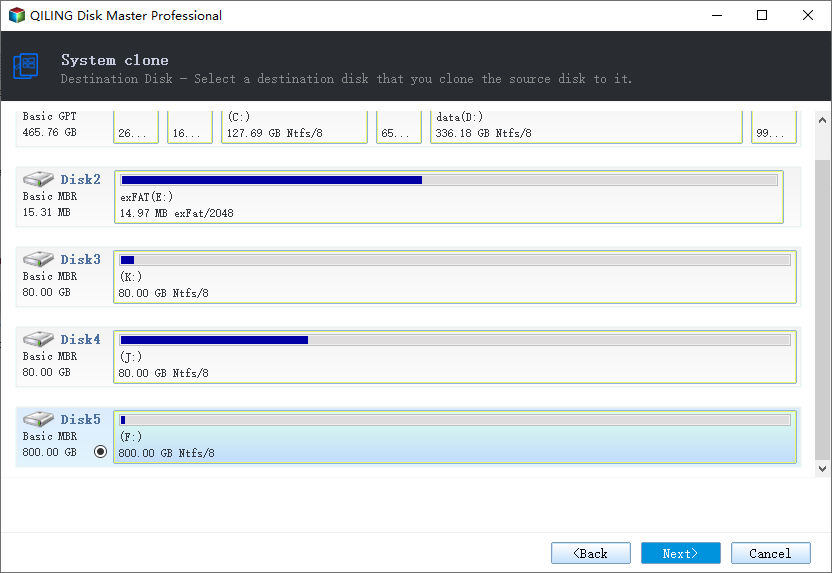
Check Warning: the data and partitions on the target disk will be deleted. Make sure that you've backed up important data in advance. If not, do it now.
Step 3. Preview the layout of your target disk.
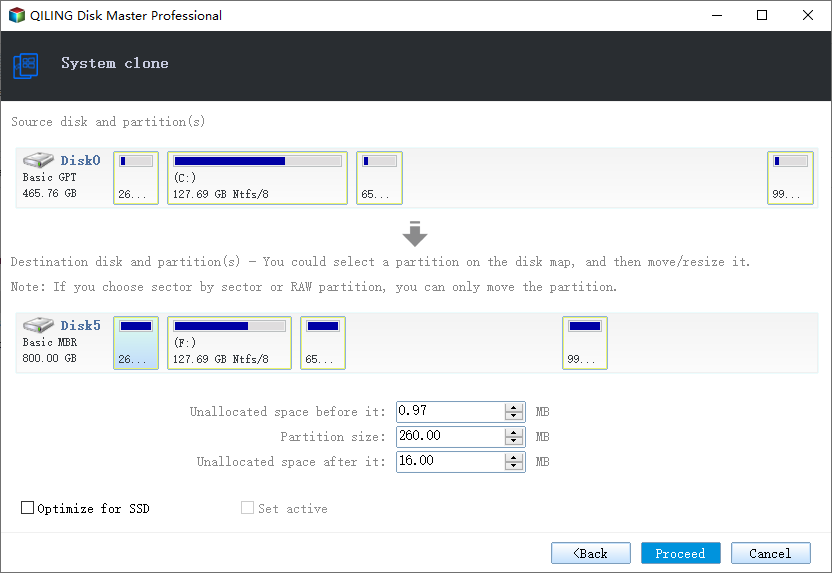
Step 4. Then click "Proceed" to start migrating your OS to a new disk.
Note: The operation of migrating OS to SSD or HDD will delete and remove existing partitions and data on your target disk when there is not enough unallocated space on the target disk. If you saved important data there, back up them to an external hard drive in advance.
15. Disable/Turn off Search Indexing
The search feature is an important and useful function of Windows 10, and the index section may temporarily occupy a large number of system resources, thereby affecting the performance of Windows 10. To speed up Windows 10 and make it run better, you can try to disable search indexing when you know where your files are located.
How to turn off search indexing:
Step 1. Type Indexing Options in the search box. Click "Modify".
Step 2. Click "Show all locations" and "Clear all the selected locations". Then, click the "OK" button.

16. Remove Unused Bloatware Software
Many PCs come with multiple pre-installed apps you don't want or need, which are in large size and cause your computer in low disk space. To free up space and make your Windows 10 run faster, you can uninstall the bloatware.
Right-click the Start menu, choose "Control Panel" > "Programs" > click "Uninstall a program". Select the programs you no longer need and click "Uninstall" at the top of the list.
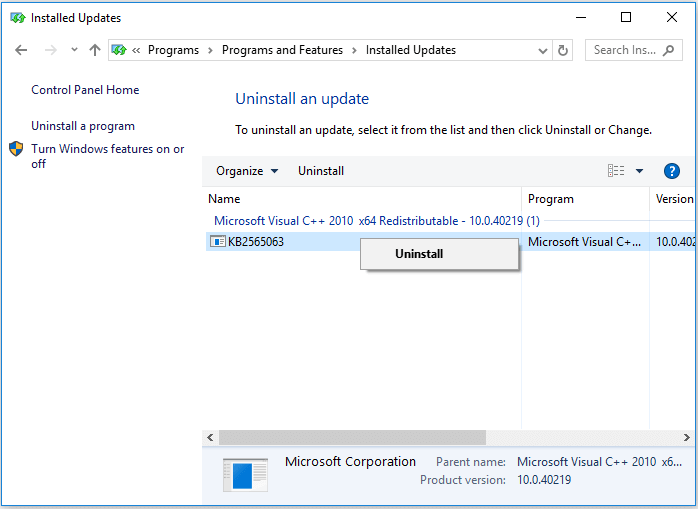
17. Shut off Windows Tips and Tricks
Another practical solution is to turn off tips and notifications on Windows 10. When Windows 10 gives you tips, it will scans, which can have a slight impact on performance. If Windows doesn't need to generate a notification, your computing will go faster.
To turn off these tips, go to "Start" > "Settings" > "System" > "Notifications & actions" and toggle off "Get tips, tricks, and suggestions as you use Windows".
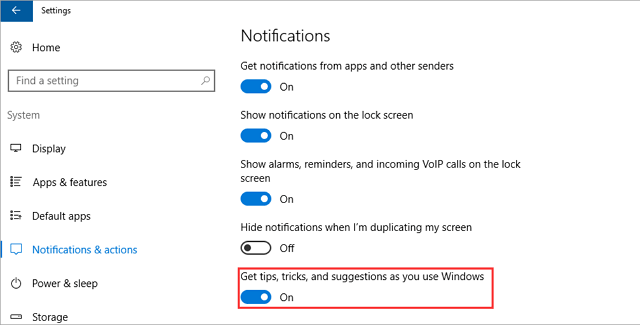
18. Check for Viruses and Malware
If your computer has been infected by a virus, malware, or malicious software, it may run slowly. The best way to remove viruses and malicious software is to try to prevent them by running antimalware and antivirus software and keeping it up to date, like Bitdefender, Norton, Kaspersky, Avast, etc.
You can also scan your PC for viruses or other malicious software by using Windows Security, which is included in Windows 10.
19. Upgrade Your RAM/Add More RAM
To speed up Windows 10, one of the most effective ways is increasing the amount of virtual memory (RAM). Windows 10 requires a minimum of 4GB to run smoothly.
When your laptop or PC has too little RAM, it cannot support too many applications to run smoothly, and it will run very slowly. In this case, installing a new RAM chip to increase the RAM capacity is quite effective for improving the performance of your computer.
To see the specific condition of your RAM, In Task Manager, click "Performance" and "Memory".
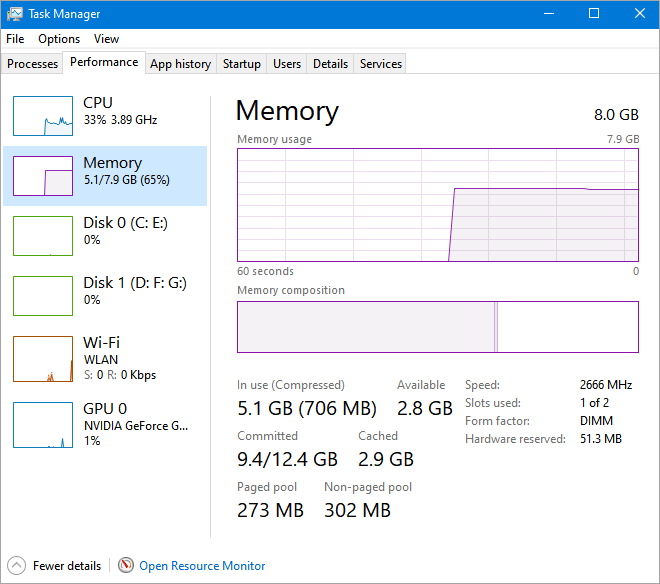
20. Run System Maintenance
Windows 10 has a built-in utility that can make routine system maintenance, such as defragmenting the hard drive, scanning for updates, and checking for malware.
These tasks are usually run in the background when your computer is idle, but if you notice system performance issues, you can run maintenance manually if you want.
Open Control Panel, select "System and Security" > choose "Security and Maintenance". Click the arrow to expand the maintenance options. Select "Start Maintenance".
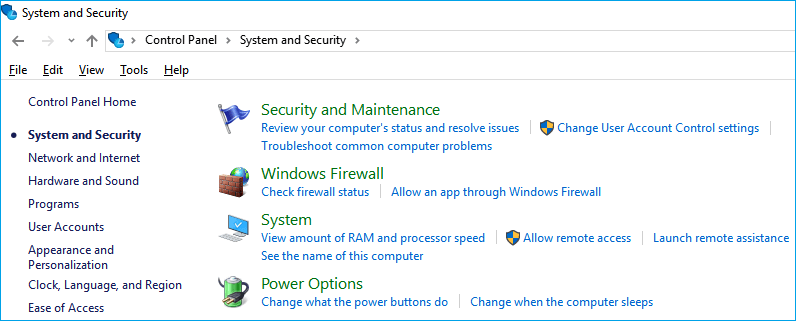
To Sum Up
This article provides you with the most comprehensive methods on how to speed up Windows 10, such as restart your PC and open only the apps you need, use ReadyBoost to help improve performance, check for low disk space and free up space, extend your system drive, upgrade to an SSD, increase the Capacity of RAM, and more. You can choose whatever tip you think is best for your computer situation and improve its performance.
How to Speed Up Windows 10 FAQs
Check the following questions that are highly relevant to how to speed up Windows 10 and make it faster.
1. Why is my Windows 10 computer so slow?
- Virus or malware attack
- Slow on startup
- Run out of disk space
- Dirty fan or heat sink
- Windows system issue
- Hard drive issue
- Virtual memory not enough
2. How can you increase your computer speed?
To increase your computer speed, you can:
- Install the latest updates for Windows and device drivers
- Restart your PC and open only the apps you need
- Use ReadyBoost to help improve performance
- Make sure the system is managing the page file size
- Check for low disk space and free up space
- Adjust the appearance and performance of Windows
- Stop OneDrive syncing
- Disable unnecessary startup programs
- Check for viruses and malware
- Restore your PC from a system restore point
3. How can I make Windows 10 2021 faster?
How to speed up Windows 10 2019, 2020, or 2021:
- Restart your PC
- Check for update
- Check startup apps
- Run Disk Cleanup
- Remove unused software
- Disable special effects
- Disable transparency effects
- Upgrade your RAM
- Use an SSD
- Run System Maintenance
Other Topics You May Like
- Best Free NAS Backup Software – Qiling
- How Do You Backup Your Computer Data? Find the Best Way to Protect Data!
- How to Fix Second Hard Drive Not Showing Up (Updated)
- Resize/Move Partitions to Solve Low Disk Space Issue
- Convert Unallocated Space to Free Space Windows 11/10
- How to Perform Free Hard Drive Test or Diagnostic to Repair Disk Errors in Windows 10/8/7
Related Articles
- Why Does My Computer Keep Blue Screen | 100% Solved
Do you have the issue of the computer keeping a blue screen? If yes, you are in the right place. This article gives a complete tutorial on what a blue screen means, why it appears, how to troubleshoot it, and some practical tips to prevent the computer blue screen of death. Keep reading and find your solution. - A Quick Answer to: Will Updating My BIOS Delete Anything?
Updating BIOS is something you might have heard about. But have you ever been stuck on a question like, 'Will updating my BIOS delete anything?' This article will describe whether updating BIOS will delete anything on your PC and offer a tool called Qiling Disk Master to protect your data. - How to Backup Windows 10 Before Upgrading to Windows 11✅
Are you looking to install the latest Windows 11 OS on your PC? If so, follow our step-wise guide on how to backup Windows 10 before upgrading to Windows. - How to Perform Windows Folder Backup [Step-by-step Guide]
This page covers Windows folder backup, elaborates on two ways to finish a Windows folder backup, and introduces a professional backup tool.